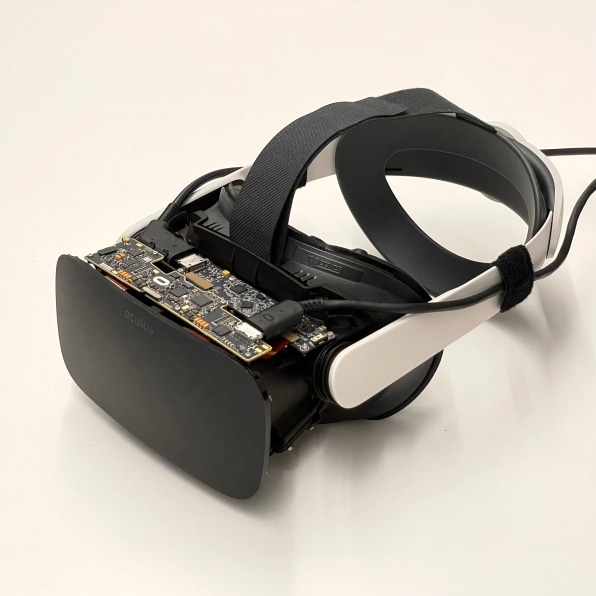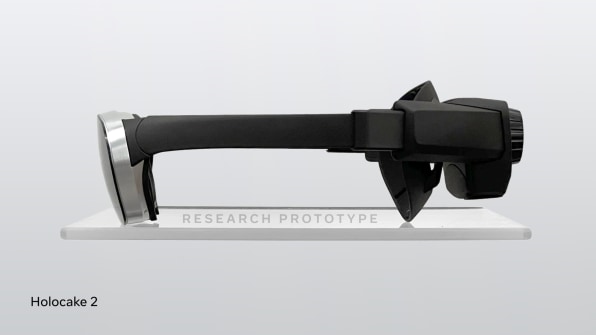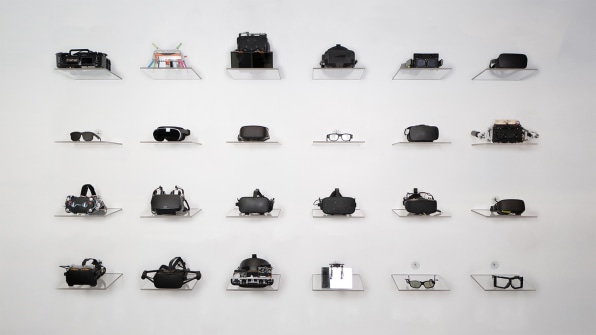[ad_1]
Last week, during a virtual “Inside the Lab” presentation for tech reporters, Meta CEO Mark Zuckerberg and other executives showed off a bevy of prototype virtual-reality headsets developed by the company’s Reality Labs Research group.
This experimental hardware included several versions of the company’s “Half Dome” headsets, which use varifocal lenses to keep items in focus wherever they sit in your virtual view. Then there was the “Butterscotch” headset, with a high-res display so crisp you can read the bottom line of a virtual eye chart. And “Starburst,” which makes VR feel more real by packing 20,000 nits of display brightness compared to the Quest 2 headset’s 100 nits. And “Holocake 2,” whose thin holographic lenses make for a much slimmer headset than designs currently on the market.
In every case, it was clear that the headset in question wouldn’t reach consumers in anything like its current form. For instance, the Half Dome’s varifocal displays rely on eye-tracking technology that isn’t yet reliable enough for commercial deployment. The Butterscotch unit ramps up display resolution by cutting the field of view in half, resulting in an unnaturally narrow image. Starburst is too gargantuan a piece of equipment to wear strapped to your head; instead, you hold it up to your eyes using handles. And Holocake 2 needs to be hooked up to a PC rather than offering a stand-alone VR experience.

Zuckerberg, Reality Labs chief scientist Michael Abrash, and other execs were cheerfully forthcoming about these gotchas. In fact, they were part of the point of the whole event. Over the long term, Meta aspires to build a metaverse that’s as realistic as old-fashioned reality—a bar the company refers to as passing a “visual Turing test.” By revealing its prototypes, the company showed that it’s making progress—but also emphasized how immense the undertaking is.
It’s rare for a big tech company to share as much about work in progress as Meta is doing.
Now, it’s possible that Zuckerberg’s eagerness to show Meta’s progress is a reaction to recent developments that might leave outsiders wondering if the company’s hardware efforts were in disarray. Last week, The Information’s Sylvia Varnham O’Regan reported that the company had decided not to ship “Project Nazare,” a set of AR glasses it had been planning to release in 2024, pushing any introduction of a commercial product even further into the future. Her story also said that the first generation of a planned Meta smartwatch had been canceled, and followed an earlier report by Reuters’ Katie Paul that the company was cutting back on some hardware projects to focus on its most strategic work.
Still, whatever Meta’s motivations—and no matter how long it takes to ship any products—it’s rare for a big tech company to share as much about work in progress as it’s doing. Apple, as is its wont, is developing its mixed-reality headset in secrecy; last month, Bloomberg’s Mark Gurman reported that it’s far enough along to have been demonstrated at a meeting of the company’s board. Google, meanwhile, recently showed real-time translation via AR glasses, teasing its product under development in a limited way.

As someone who’s curious about this stuff, I’m grateful that Meta has chosen a less stealthy path. Would it have been fun if Apple had created the iPhone in public, updating us all on its activities from the moment it decided to build a smartphone? Of course it would have been! With Meta’s efforts in VR and AR, we’re getting a chance to see some of its research and thinking long before they result in anything that’s shippable.
But it would be a mistake to get prematurely enthusiastic over anything Zuckerberg and company have been disclosing. For one thing, we have to rely on Meta’s own assessments of its prototypes—the company conducted its “Inside the Lab” presentation via Zoom webinar, so it was impossible for those of us who attended to gauge the quality of the tech being previewed. And we only know what Meta is choosing to tell us: Though presenters pointed out some of the obstacles they haven’t yet overcome, even more went unaddressed, such as the impact all of this advanced technology has on headset battery life.

More important, isolated examples of technical progress don’t have all that much to do with whether Meta can create a metaverse that people will actually want to inhabit. The company’s desire for its display hardware to pass a self-assigned “visual Turing test” is a very long-term goal. If it can’t get a lot of other things right in the interim—and overcome widespread cynicism about the very idea of inhabiting a virtual world envisioned by Mark Zuckerberg—it might give up before it gets there. Or it could ship something that’s a technological wonder in some respects—but is still compromised and unappealing. Or, somebody else’s less visually splendiferous virtual world might already be too deeply entrenched for Meta’s superior hardware to matter much.
Someday, we’ll know how Zuckerberg’s decision to bet his company on the metaverse played out. That’s when the impact—or lack thereof—of its current prototypes will be clear. For now, it’s fine to enjoy the glimpse we’re getting without overthinking its long-term implications.
[ad_2]
Source link

